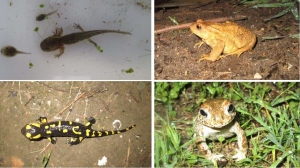ARTICLE / "Monitoring of amphibians in Ribes del Ter and Llémena in the framework of the LIFE + PotamoFauna project (LIFE12 NAT/ES/001091)"
Iago Pérez Novo 1 4, Carles Feo 2, Quim Pou-Rovira 2, Teia Puigvert 3
1 Societat Catalana d’Herpetologia, Museu de Ciències Naturals de Barcelona. (Museu Blau), Plaça Leonardo da Vinci 4-5, 08019 Barcelona.
2 Consorci de l’Estany, Plaça dels Estudis, 2, 17820 – Banyoles.
3 Consorci del Ter, Passeig del Ter, 2 (Museu del Ter) 08560 – Manlleu.
4 (Necessites javascript per veure aquest correu-e)
The destruction and alteration of habitats is the first cause of loss of biodiversity of amphibians in many places on the planet. In Catalonia, the optimal habitats for this animal group are also altered, including small wetlands linked to rivers with artificial fluvial dynamics such as Ter. The great avenues don’t happen anymore due to reservoirs and dikes. Consequently, the control of the river flow has caused the disappearance of many micro-wetlands that formed on the banks due to floods generated by natural avenues. The LIFE Potamo Fauna project has as one of its objectives to monitor the amphibians that live in the micro-wetlands of 6 locations in Ribes del Ter and Llémena rivers to know the degree of conservation of the populations adjacent to the river. During the project, small wetlands have been created in 4 of the 6 locations studied, and special attention is being given to the colonization of these new environments for amphibians.
Until 2016, there were 8 species of amphibians in the study area, 6 frogs and toed (Discoglossus pictus, Pelophylax perezi, Hyla meridionalis, Alytes obstetricans, Bufo calamita and Bufo spinosus) and also Salamandra salamandra and Lissotriton helveticus. Lately, in the first samples of 2017, a sub-adult of Pelobates cultripes has been observed. With this finding, there would be 9 species detected in the study area. Regarding the number of species in the different localities, it has been seen that the localities that run upstream from Girona have obtained a greater amphibian wealth than the downstream localities, which corroborates the degradation of the riparian habitat of waters down the River Ter. Amphibian reproduction has also been higher upstream.
The small wetlands created in 2015 in the different riverside towns have obtained, until 2016, values of wealth ranging from 3 to 4 species. Lately Lissotriton helveticus has colonized the newly created pools of the Llémena river, therefore we can already talk about a new species favored by the creation of aquatic habitats near the river. The micro-wetlands that were created in 2016 in Sobrànigues have only been colonized by 1 species, Discoglossus pictus. 56.3% of the newly created ponds have remained dry during the study period, although the possibility is not ruled out that they are filled with future floods. The fact that they are in temporary environments has helped to prevent invasive species such as the American Crayfish (Procambarus clarkii), most damaging to amphibians, for the most part of the new ponds.
Reproduction has been detected at 34.4% of the newly created pools so far. Out of the 9 species detected in the whole area of study, 5 of them have used the new basins as a breeding spot. With the creation of micro-wetlands, it has contributed to improving the populations of two species of special European interest: Alytes obstetricans and Hyla meridionalis, as well as other species, both amphibians and aquatic invertebrates
Also worth mentioning is the last action carried out by the Consorci de l’Estany in April: the rescue of the Clot d'Espolla marsh amphibian before it getting dry, and the translocation back into the newly created micro-wetlands of the Llémena, prior to pathogen analysis. In the last months / years the effectiveness of this action can be assessed.
In summary, the LIFE Potamo Fauna project has managed to create new micro-wetlands to solve the problem of lack of aquatic habitats adjacent to the river. The colonization and reproduction on the part of the amphibians has been very successful in most of the ponds that have maintained water during the spring.

















